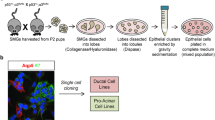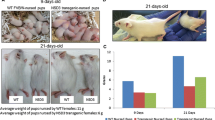Abstract
In an attempt to induce adenocarcinoma containing myoepithelial cells (MECs) in the rat submandibular gland, we injected 7,12-dimethylbenz(a)anthracene (DMBA) dissolved in acetone into the glands of rat pups at the age of 10 days. In both male and female pups, the glands, including their developing terminal secretory units, contained far greater numbers of cells positive for proliferating cell nuclear antigen (PCNA) than did adult glands. A single administration of 1% DMBA (0.05 ml/130 g b.w.) did not produce adenocarcinoma, but did induce occasional sarcomas, such as rhabdomyosarcoma and fibrosarcoma, in 2 months. Most glands regenerated with minimal scar formation. Microscopically, these glands were atypical in that they contained increased numbers of PCNA-positive cells, underdeveloped granular ducts, and striated ducts surrounded by MECs positive for alpha smooth muscle actin (αSMA). Though these features were also observed in the regenerated glands after acetone injection, the number of PCNA-positive cells was relatively high in the glands of DMBA-treated females, especially in the terminal secretory unit. The second DMBA injection at 10 weeks of age produced adenocarcinoma made up of αSMA-positive MECs and keratin 19-positive duct cells. Such MEC-associated adenocarcinoma was induced in the glands of more than half the female but not the male animals. Replacement of either of the double DMBA treatments with acetone, or DMBA treatment, single or double, of adult glands did not produce adenocarcinoma, but did produce sarcoma and squamous cell carcinoma. These results suggest that (1) at least two genetic mutations are necessary for induction of adenocarcinoma with MECs in the rat submandibular gland, (2) the mutation is efficiently introduced to pup glands whose terminal secretory units exhibit extreme proliferative activity, and (3) the second mutation is difficult to introduce in male glands, whose proliferative activity is relatively low, and/or transformed cells need some female hormone after the mutation to propagate.
Similar content being viewed by others
Author information
Authors and Affiliations
Additional information
Received: 21 December 1999 / Accepted: 10 March 2000
Rights and permissions
About this article
Cite this article
Ogawa, Y., Wan, F., Toyosawa, S. et al. Induction of adenocarcinoma containing myoepithelial cells in rat submandibular gland by 7,12-dimethylbenz(a)anthracene. Virchows Archiv 437, 314–324 (2000). https://doi.org/10.1007/s004280000223
Issue Date:
DOI: https://doi.org/10.1007/s004280000223




